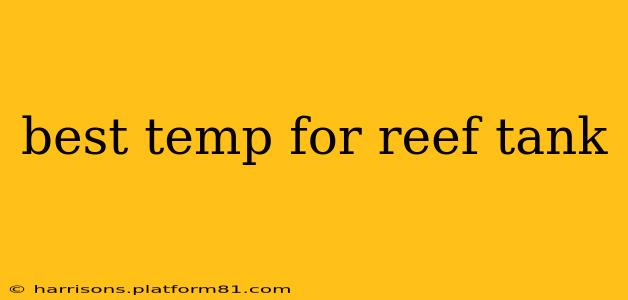Maintaining the ideal temperature for your reef tank is crucial for the health and survival of your corals, fish, and other inhabitants. A stable temperature range mimics their natural environment, promoting growth, vibrant colors, and overall well-being. But what exactly is the best temperature, and how do you maintain it? Let's dive in.
What is the Ideal Temperature for a Reef Tank?
The optimal temperature range for most reef tanks sits between 76°F and 82°F (24°C and 28°C). While a few degrees above or below this range might be tolerated for short periods, consistent deviation can lead to stress, disease, and even death in your tank's inhabitants. The "best" temperature within this range often depends on the specific species you're keeping. Researching the needs of your individual corals and fish is paramount.
Why is Maintaining a Stable Temperature So Important?
Temperature fluctuations in a reef tank can have significant negative impacts:
- Coral Bleaching: Sudden or sustained temperature increases can cause corals to expel their symbiotic algae (zooxanthellae), leading to bleaching and potentially death.
- Disease Susceptibility: Temperature instability weakens the immune systems of your tank inhabitants, making them more vulnerable to diseases and parasites.
- Reproductive Issues: Many marine invertebrates have specific temperature requirements for successful reproduction. Inconsistent temperatures can disrupt this process.
- Metabolic Stress: Significant temperature changes force your tank's inhabitants to work harder to regulate their internal temperature, leading to stress and reduced overall health.
How to Maintain the Ideal Temperature in Your Reef Tank?
Maintaining a stable temperature requires a multi-pronged approach:
- High-Quality Heater: Invest in a reliable aquarium heater with accurate temperature control. Choose a heater sized appropriately for your tank's volume.
- Thermometer: Use a reliable thermometer, preferably one with an alarm function to alert you to temperature deviations. Consider both a submersible thermometer inside the tank and an external one to monitor ambient temperature.
- Regular Monitoring: Check your tank's temperature regularly, at least once a day, ideally twice.
- Proper Tank Placement: Avoid placing your tank in direct sunlight or near sources of heat or drafts.
- Consider a Chiller: In warmer climates, or for tanks with high-output lighting, a chiller might be necessary to prevent overheating.
- Regular Maintenance: Keep your filter and other equipment clean to prevent overheating due to restricted water flow.
What Temperature is Too High for a Reef Tank?
Temperatures consistently above 82°F (28°C) are generally considered too high for most reef tank inhabitants. Prolonged exposure to these temperatures significantly increases the risk of coral bleaching and other health problems.
What Temperature is Too Low for a Reef Tank?
Temperatures consistently below 76°F (24°C) can also be detrimental, slowing down metabolic processes and increasing susceptibility to disease. Some corals and invertebrates may not survive prolonged exposure to colder temperatures.
How can I tell if my reef tank temperature is off?
Signs of an incorrect temperature can be subtle but should be addressed promptly. Look out for:
- Lethargy or unusual behavior in fish: Are they less active than usual?
- Pale or bleached corals: This is a clear sign of stress, often caused by temperature changes.
- Increased algae growth: An unexpected spike in algae could indicate an imbalance caused by temperature fluctuations.
- Increased disease incidence: More frequent occurrences of disease among tank inhabitants could point to a temperature problem.
Maintaining the correct temperature in your reef tank is a crucial aspect of responsible reef keeping. By diligently monitoring and controlling the temperature, you'll create a thriving environment for your marine life, ensuring their health, longevity, and vibrant beauty. Remember to always research the specific needs of the species you keep to ensure their optimal well-being.
